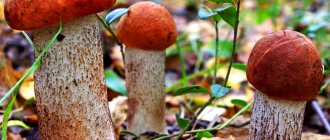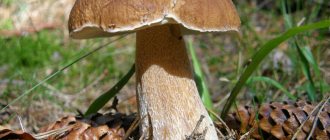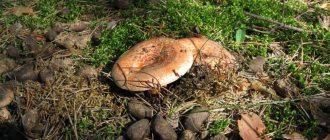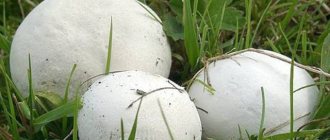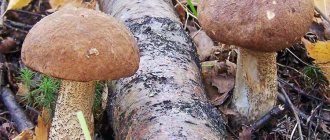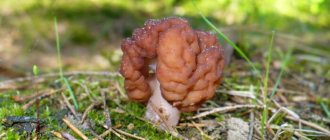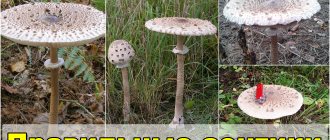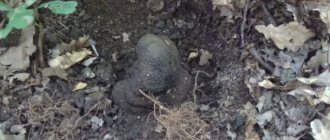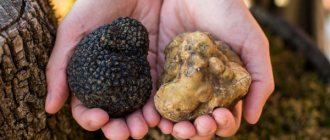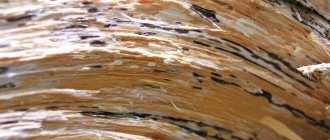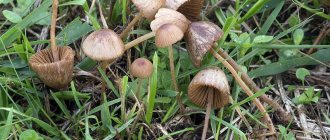How to cook properly
Boletuses and boletuses are tasty and healthy in any form. They can be fried, boiled, stewed, baked and pickled. For the winter, these mushrooms are often dried and frozen.
Preliminary preparation
Obabki are also loved by mushroom pickers for the reason that they do not require painstaking cleaning.
They are quite large and clean on their own (there is no need to remove the film from them, as for example with butter, soak or cut off the legs).
If necessary, only cut off the base of the mushroom and remove damaged areas. A large specimen is cut into several parts to make it easier to cook or dry.
The wormy parts of the shoots should be immediately cut off and thrown away, since the worms quickly spread to healthy fruiting bodies.
Before cooking, boletus and aspen mushrooms are thoroughly washed with water. Before drying, it is better not to wash them, but to wipe them with a slightly damp cloth, after removing any stuck leaves or twigs.
Cooking rules
Before cooking (frying, stewing, baking), the obabki must be boiled. When the water boils, you need to pour it out and replace it with a new one - cold, and cook for about an hour, periodically removing the foam. If mushrooms are boiled for soup, the first broth is also drained.
- Harvesting frozen boletus and boletus requires almost no effort. They must be cut, thoroughly washed and dried, and then placed in a bag or container. Some housewives prefer to boil the obabki before freezing. After this, they must be placed in a colander and allowed to drain excess liquid.
- You can dry mushrooms in the oven if you don’t have a special device. The pieces are laid out on baking sheets and left at a temperature of 50-60°C with the door slightly open. Stir every half hour.
- Before frying, the fruiting bodies are not boiled for very long - about half an hour, but then they are thoroughly fried (about the same amount of time). During the cooking process, potatoes, onions, meat or sour cream are added to them.
Where to look for mushroom places in Primorye?
At the beginning of August, a “hot” period begins for seaside mushroom pickers. Porcini mushrooms, milk mushrooms, white mushrooms, boletus mushrooms, boletus mushrooms, russula, boletus mushrooms, honey mushrooms, saffron milk caps and others fill the baskets of mushroom seekers. The most favorite among them is the porcini mushroom. We will now find out where to collect porcini mushrooms in the Primorsky Territory.
Despite the fact that mushroom pickers do not like to share the secrets of the rich habitats of their prey. However, there are places in Primorye where you can always find more than one mound of the desired “hats”. If you are just a beginner mushroom picker, we recommend that you visit such mushroom places as Putyatin Island (in Peter the Great Bay), the village of Blagodatnoye (in the Khorolsky district) and the village of Tavrichanka (in the Nadezhdinsky district).
Benefits and harm to the body
In cooking, obabki are valued not only for their pleasant taste. Mushrooms of this genus have a beneficial effect on the body, since they contain many useful compounds. Mushroom pulp contains:
- vitamins - B1 and B2, PP;
- vitamins E and D;
- ascorbic acid and thiamine;
- potassium and iron;
- magnesium and phosphorus;
- manganese and calcium;
- amino acids - arginine, glutamine and leucine;
- cellulose;
- a huge amount of vegetable protein.
The beneficial effect of boletus on the body is expressed in the fact that boletus and aspen boletus:
- help improve blood composition and build muscle mass;
- improve metabolism and help the body get rid of toxins;
- balance blood sugar levels and remove toxins;
- normalize the functioning of the liver and kidneys;
- compensate for the lack of vitamins and mineral salts;
- stimulate the immune system and strengthen resistance to diseases.
However, if used carelessly, mushrooms can exhibit their harmful qualities. First of all, it is not recommended to use them if you have an individual intolerance, in which case even a small amount of mushroom pulp will lead to poisoning
It is also not recommended to eat obabki:
- with pancreatitis and ulcers in a state of exacerbation;
- with frequent constipation and sluggish digestion.
The use of common boletus in traditional medicine
Due to its properties, boletus has found use in folk medicine. For these purposes, mainly dried mushroom powder and red wine tincture are used.
What to pay attention to
The common boletus is a valuable food product that is often present on the table of mushroom lovers and connoisseurs as a component of many dishes. However, during treatment, its use should be carried out on an ongoing basis and in a certain quantity.
To get a positive effect, you should take into account the beneficial properties of boletus and the contraindications that it has when using it. Also, many people, especially older people, have several chronic diseases
Only a doctor, or better yet a herbalist, can take all these points into account and prescribe the correct treatment. The information given below is for informational purposes only.
For the heart and blood vessels
The beneficial properties of common boletus have shown a good effect, mainly for the prevention of cardiovascular diseases. A course of taking mushroom preparations cleanses blood vessels, including cholesterol deposits, stimulates blood circulation, and strengthens the heart muscle.
For the gastrointestinal tract
Common boletus is a mushroom that is relatively easily digested and absorbed in the gastrointestinal tract and does not require additional digestive juices. Regular consumption of the mushroom helps improve digestion.
Kidney diseases
Treatment with boletus is recommended for both acute and chronic kidney diseases. As a prophylactic agent, mushroom preparations normalize the functioning of organs, improve their functionality, and maintain a healthy state.
For men
A good result is obtained by using the medicinal properties of the common boletus as a means to improve potency and improve the reproductive system of men.
Oncological diseases
In complex therapy for the treatment of cancer, the common boletus is valuable. Plant preparations inhibit the growth of cancer cells, promote the restoration of lost telomeres (information links) of DNA molecules, and increase the synthesis of NK cells and macrophages responsible for antitumor immunity. Thus, the common boletus is also applicable for the prevention of cancer.
For the nerves
Common boletus preparations normalize the activity of the nervous system and are used for some diseases in this area.
Skin diseases, wounds, ulcers
The beneficial and medicinal properties of the common boletus and its use have proven themselves well for the treatment of skin diseases, as well as wounds and ulcers. They have a positive effect on the condition of the skin and mucous membranes.
For these purposes, an ointment made from dried mushroom powder diluted with a small amount of boiling water is used as an anti-inflammatory and wound-healing agent. For rinsing and lotions, use a decoction/infusion of common boletus.
Joint diseases
The common boletus is recommended as an aid in the treatment of joints. The plant contains a significant amount of phosphorus and calcium, which has a positive effect on the condition of teeth, bones, musculoskeletal system, and bone marrow.
Common boletus preparations are also applicable for prophylactic purposes.
For metabolism
The medicinal properties of the common boletus have been used both for the treatment and for the prevention of metabolic disorders. A course of taking plant preparations normalizes the hypothalamic-pituitary and adrenal systems, stimulates the activity of the thyroid gland, and regulates blood sugar levels.
For beauty
Common boletus is a folk remedy for skin, hair, and nails care. Regular face masks made from crushed plant pulp make the skin elastic, smooth it, have a tonic effect, and protect against premature aging and the destructive effects of free radicals. For a more lasting result, a course of internal administration of boletus boletus preparations is carried out in parallel.
Also, a decoction/infusion of boletus is used to rinse hair after hygienic washing. And baths help strengthen nails.
The most famous varieties
Lovers of “silent hunting” really appreciate the obabok mushroom. Photos and descriptions of its most popular varieties are given below. There are about 20 species of this fungus in total, but no more than 15 are found in our country.
Black boletus obabok
It grows mainly in wetlands of birch forests. Peak fruiting occurs between July and September.
You can learn to distinguish black boletus by its characteristic features:
- The cap reaches 5-12 cm in diameter. In young specimens it is hemispherical, becoming convex with age. The edge is pressed tightly against the stem, but the cap itself can be separated from it quite easily.
- The skin is velvety, black-brown in color, and becomes slightly slippery in rainy weather.
- The tubular layer of young specimens is white, but with age it acquires a light brownish-gray tint.
- The leg is dense, gray-white and has a slight thickening at the bottom. A characteristic feature is the presence of black-brown protruding scales over the entire surface of the leg.
The pulp of black boletus is white and elastic, does not change color when cut and has a pronounced mushroom smell.
Boletus turning pink
Another edible variety that can be found in birch or pine-birch forests. Sometimes it grows along the edges of swamps. Fruiting lasts from July to October.
This edible mushroom also has its own characteristics:
- It has a fleshy cap up to 15 cm in diameter. In young boletuses it is roundly convex, but with age it becomes prostrate.
- The skin is dry, colored gray-brown or dark gray. The entire surface of the cap is covered with a marble pattern of a lighter shade.
- Under the cap there is a tubular layer of white or cream color.
- The leg is up to 10 cm in length, painted dirty white, and has frequent black-brown scales.
- The flesh is light, but quickly turns pink or red when cut. It has a pleasant mushroom aroma and sweet taste.
Other
There are other varieties of edible obabka mushroom:
- White boletus - grows in birch and mixed forests, less often in aspen forests. The cap has a standard shape for this group, and its skin is white with a pink or brown tint, becoming yellowish with age. The pulp is white and dense. At the cut of the cap it turns blue, and at the stem it acquires a purple tint.
- Red obabok (redhead) - found in large groups in young aspen forests and small forests. The fruiting period is from July to September. The cap is up to 15 cm in diameter, colored yellow-red, orange-red or brown-red. The tubular layer is white, acquires a yellowish tint with age, and darkens when pressed. The flesh is white, but quickly turns blue when cut.
- Yellow-brown boletus: a mushroom with a hemispherical cap up to 20 cm in diameter. The skin is rough, colored from yellow-gray to bright red, depending on the place of growth. The pulp is white and elastic. Immediately after cutting it turns pink, but over time it darkens to black. It is found on sandy, rocky and peaty soils in birch and aspen forests.
- Boletus boletus: A rare edible mushroom that can be found in dry pine forests with lots of moss. The cap can reach 15 cm in diameter, the skin is painted in an unusual dark crimson color. The tubular layer under the cap is white, but turns red when pressed. The pulp is white, but quickly turns black when cut, and has no pronounced odor.
Morphological characteristics
All species united by the name “obobok” are characterized by the presence of the following common morphological characteristics:
- large size, hemispherical or prostrate cap;
- the surface of the cap is smooth, felt or velvety, matte;
- tubular type hymenophore of free type or notched type, quite easily separated from the cap;
- tubes of a whitish, gray or yellow color, with the presence of small and round pores that darken with aging;
- cylindrical leg with slight thickening downwards, with a scaly or fibrous surface;
- the flesh of the mushroom is white in color, changing when cut to reddish, dark blue-violet or black;
- During heat treatment, the pulp turns black.
The category of obabka includes more than twenty species, of which 15 species of edible obabok grow in the soil and climatic conditions of our country.
How to grow boletus?
It is very easy to grow boletus at home, and there is a great chance of getting a rich and tasty harvest compared to other types of mushrooms.
Sowing rules
It is difficult for the spore sac to be separated from the pulp. Therefore, the task of the person who will grow the mushrooms is to make a mixture that will ensure that the spores precipitate.
For such a solution you should take:
- 1 part mushroom pulp;
- 100 parts water.
Next, the root of the tree (birch) is opened and the finished mixture is poured into it. You will need to water the roots periodically. In the dry season, the soil is systematically sprayed with a spray bottle, this will prevent the soil from becoming waterlogged. To prevent the sun from hitting the birch tree, the beds should be watered after lunch.
Moisturizing is needed not only when the mushrooms emerge, but also when the first fruits appear. There is no need to fertilize the soil; just water it daily with plain water. The harvest will be ready within a year after sowing.
How and where is it better to sow?
To sow obabka, you should choose a site close to birch or where they grow with other trees. This could be a garden where fruit or other deciduous trees grow.
- A 10 cm layer of birch sawdust mixed with birch bark is poured into the prepared holes.
- Humus is sprinkled on top, taken from the forest under the birches.
- Next, a layer of mycelium is poured.
- The last layer should consist of sawdust.
Mycelium preparation
To get 100% results, it is recommended to prepare all the necessary materials. The best time to sow obabka is May or August. By the time of sowing, the site must be fully prepared, namely, all garbage and unnecessary objects must be removed, and the soil must be dug up. The birch tree around which mushrooms will grow should not be younger than 4 years old.
The depth of the hole is 20 cm, and the diameter is about 10 cm, into which soil and peat are poured. You can purchase the most common mixture at any flower shop. The mycelium is placed in the hole, and the holes are filled with soil and compacted.
How to get a rich harvest?
In order to always maintain optimal humidity in the holes, it is recommended to cover the beds with straw; the layer should not exceed 30 cm. The straw is laid out wet and should be watered from time to time. If the beds are watered with preparations containing useful microelements, the yield will increase by 60%.
The beds are covered with straw when the first cold weather sets in; if it is not possible to purchase straw, it can be replaced with moss. If you properly care for and water the beds in a timely manner, the mushrooms will delight you with their harvest for 7 years.
The closer the conditions are to natural, the better the mushrooms will grow. It is better to make holes around several trees, this way you will get more harvest.
The obabok mushroom is edible, one might even say it’s tasty and aromatic, you can use this mushroom to prepare a lot of dishes, seasonings, sauces, etc.
When going for mushrooms, it is important to carefully study all types of mushrooms, since they can be confused with poisonous mushrooms. Also, obabok can be easily grown at home and get a harvest every year
Rules for growing rows
By and large, it doesn’t matter what type of row: Row or tricholoma is a very large family of fungi, consisting of about ... You will plant - seeds or mycelium. The main thing is that the planted material is in the most favorable conditions for it:
- The bed should be constantly wet, but in moderation.
- During the period of mycelium growth and development, the soil temperature should be at least 20°C.
- The garden bed must be protected from direct sunlight and rain.
- If they are grown indoors, it must be lit, otherwise the legs will grow tall, but with a small cap.
- The harvest is harvested when the caps become more or less flat.
- After each harvest, you need to cover the bed with a 5-centimeter layer of fresh soil.
- In winter, when the air temperature drops below 5°C, the bed should be covered with a cloth, and on top of it a 10-centimeter layer of leaves or straw.
Well, in conclusion, let us remind you once again that Ryadovka or Tricholoma is a very extensive family of mushrooms, consisting of about ... - an autumn resident, and therefore in the open ground you should not count on more than one harvest per year.
Far Eastern obabok - description of where it grows, the toxicity of the mushroom
The porcini mushroom has long been considered the best in the mushroom kingdom and rightfully occupies a leading place in all positions, maintaining a confident first place in all respects. But this is in Europe, and in the Far East there is a mushroom that confidently outshines boletus mushrooms in all respects - both taste and aesthetics. This is a Far Eastern obabok. It is one of the most collected and popular mushrooms in the region.
Description
Obabok is one of the names of boletuses, boletuses and redheads. The mushroom belongs to the Boletaceae family and grows (as the name implies) in the forests of the Far East.
The cap of a mature mushroom is hemispherical in shape and can grow up to 25 centimeters. In newly born mushrooms it resembles a ball, slightly wrinkled, with the edges pressed to the stem. In more mature mushrooms, remnants of the cover are visible. The skin color is brownish-ochre. In the lower part, the surface is tubular in a bright yellow hue, darkens over time and becomes olive-yellowish. In the place where the cap connects to the stem, the tubes are slightly dented.
When the weather is dry, the skin cracks a little, exposing the whitish flesh. The leg is cylindrical, somewhat curved, thickens towards the lower part, full, without voids, strong, tall, can reach 13-14 centimeters in height and 2.5-3 centimeters in thickness. The lower part is dark, gradually lighter towards the top. The surface is covered with small brownish scales consisting of hyphae bundles. The color is the same as that of the cap - ocher, only a little lighter.
The spores are spindle-shaped, pale brown. Over time, the spore layer slowly protrudes from under the cap.
Places of distribution
Far-Eastern beetroot grows in the southern regions of Primorye, choosing oak forests. They develop at a truly amazing speed - in a day the mushroom grows 4 centimeters and gains 10-15 grams. After three or four days they are already strong, well-fed mushrooms, and after 7-10 days they become old, useless and wormy.
They prefer to grow in colonies or several at a time, sometimes appearing solitary in front of mushroom pickers. But single mushrooms are rare. If the year is fruitful, then in a very small area you can collect a whole bucket of trash in a couple of hours. It begins to grow from June to November, bears fruit in late summer - early autumn. A particularly large harvest can be harvested in August-September.
Preparation
In terms of culinary qualities, Far Eastern mushrooms are worthy rivals to boletus and porcini mushrooms in all types of culinary processing: they can be boiled, preparing delicious soups, fried on their own or with anything, pickled, prepared delicious pies and casseroles, made mushroom seasonings, dry for future use during the winter cold, making powder for broths. Any dish prepared from obabak will have a great taste and smell amazing.
To prevent dishes from turning black, it is best to use only the caps for boiling or frying, while the legs are best added to soups or used to make sauces.
Cook the obabki for 45-50 minutes in lightly salted water, in two waters - the first is drained after a few minutes.
Benefit
Obabok not only tastes good and smells good, it contains many substances useful to the human body - proteins, various minerals, fats, mono- and disaccharides, carbohydrates, fatty acids. The mushroom also contains many vitamins and beneficial microelements.
Vitamins B and E, ascorbic acid, phosphorus, iron metals, calcium, sodium, potassium and magnesium, dietary fiber. Thanks to the latter, toxins and harmful substances and waste contained in the body are eliminated through urine.
- If the body does not tolerate some of the components of the drug.
- If children under eight years old eat these mushrooms.
- If mushrooms are eaten by a person suffering from ulcers, gastritis and other diseases of the digestive system.
How obabok is used in folk medicine
There is an opinion, proven by practice, that with the help of obabka you can cure kidney diseases. It is believed that these mushrooms help normalize human blood sugar and help cope with neurological diseases.
Since obabok contains a fairly small amount of calories, it can be safely included in the menu of any diet. Anyone trying to get rid of extra pounds can say goodbye to excess weight by eating junk.
Is the speckled oakberry edible or not?
Speckled Oak (Boletus erythropus) is part of the Boletaceae family. It is considered conditionally edible. It also has other names:
- red-legged boletus;
- bruise;
- boletus;
- granular boletus;
- grain-footed oakwood;
- subdubnik.
Description
The cap of this mushroom is matte, resembles velvet, and may have mucus. Its size ranges from five to twenty centimeters. It is shaped like a pillow or has a more rounded, spherical shape. The cap is dark brown, black-brown, dark brown, sometimes with an olive or red tint. As the mushroom ages, it becomes bare. When its surface is pressed or damaged, this place darkens and takes on a bluish tint.
The inside of the mushroom is yellow. When a mushroom picker cuts it, the cut area almost immediately turns blue or has a greenish tint. The leg has a barrel-shaped or cylindrical shape, and can thicken towards the bottom as the oak tree grows. The inside of the leg is brown or red, there is no taste or smell. On the outside there are reddish scales and specks. Its color is red-yellow, there is no mesh. Dimensions range from five to fifteen centimeters in height, and up to four centimeters in diameter.
If you look under the cap, you can see olive, yellow-green or yellowish tubes. There are also small round pores that are yellow in color and turn reddish or orange as the mushroom ages. They also darken when injured. The spores are brown-olive, their shape is spindle-shaped, and smooth to the touch.
Places where speckled oak grows
Europe, Eastern Siberia, the Caucasus are the places where this mushroom grows. In the western parts of Siberia and the East it is found much less frequently. Just like in Russia.
Likes to settle under trees such as beeches, fir trees, oaks, and firs. Its roots form a symbiosis with the rhizomes of trees. It also grows in marshy soil, along with moss. The choice of place of growth is influenced by its love for acidic soil. New mushrooms appear from May to October.
Is it possible to eat speckled oakberry?
These mushrooms are conditionally edible. To eat them, you need to cook them for about 15 minutes and then pour out the water in which they were boiled. After this, various dishes can be prepared from oak trees, used for side dishes or sauces. After cooking, they practically do not decrease in size. These mushrooms have a lot of aromatic pulp. When fried, dishes turn out very tasty, their beneficial properties are not lost, and they give off a pleasant aroma. In addition, duboviks can be prepared in any form: pickled, dried, salted. Mushrooms for every taste.
Similar mushrooms
These mushrooms, like many others, have many “brothers” similar to themselves. You need to know this and be able to distinguish between them. These include:
The yellow boletus usually grows in the western part of Europe. It differs from a bruise in its brown-yellow color. Kele's Dubovik is rare. Prefers calcareous soils. It differs in the color of the cap: it is lighter and brownish-yellow in color. The olive-brown oak tree has a speckled mesh pattern on the stem. Satanic mushroom is a poisonous species
In this case, it is especially important not to confuse the mushrooms. Differs from oak wood by an unpleasant odor
In addition, when cut, it does not immediately turn blue; it first turns red.
Useful properties of speckled oak
Dubovik contains useful substances:
- Microelements: copper, zinc, manganese, iron. Copper promotes the formation of blood cells, participates in the body's metabolic processes and the synthesis of pituitary hormones. Zinc improves the functioning of the gastrointestinal tract. Increases the absorption of various nutrients, improves food digestion due to accumulation in the pancreas. Iron is necessary for the formation of hemoglobin, which carries oxygen in the body. A very small portion of mushrooms contains a whole daily dose of microelements.
- Amino acids improve memory, mental abilities, and lead to normal coordination of movements.
- Beta-glucans are beneficial for the immune system and have a negative effect on cancer cells.
In addition, these mushrooms reduce the risk of atherosclerosis.
Eating speckled oakweed!
It must be remembered that mushrooms are conditionally edible and should be consumed with caution. Children under twelve years of age should not eat mushrooms
The fact is that they are specific and “heavy” food. They contain chitin, which has a structure intermediate between plant and animal. It is useful for adults, but is not absorbed in the gastrointestinal tract of children.
https://howtogetrid.ru/dubovik-krapchatyj-opisanie-gde-rastet-yadovitost-griba/
How to fry obabki with potatoes?
Obabki will be very tasty if you fry them with potatoes. This dish turns out flavorful and satisfying.
Will be needed
- 4 potatoes;
- 250 grams of mushrooms;
- 1 onion;
- 2 cloves of garlic;
- salt and pepper to taste.
- The obabki must first be peeled and boiled in salted water for 20 minutes.
- We cut the potatoes into large slices, the onion into half rings, and the garlic into small slices.
- In the first frying pan, fry the potatoes, adding salt and spices at the very end of cooking.
- In a second frying pan, the onion is first fried (until golden brown), and then mushrooms are added to it. You need to fry until the liquid has completely evaporated.
- Next, add salt to the mixture of mushrooms and onions, add garlic and spices, turn off the heat and leave covered for another 5 minutes.
Before serving, mix the potatoes with mushrooms and serve hot.
Obabka mushrooms are one of the most valuable edible varieties. They are not only attractive in appearance, but also contain vitamins and minerals valuable for the human body. In addition, they are excellent for pickling and pickling, so every lover of “silent hunting” has the opportunity to prepare a tasty preparation for the winter.
Varieties
boletus
The old guy has a poisonous double
The fruiting period of boletus begins at the end of May and continues until the last days of October.
Edible varieties:
- ordinary, or subgrown - cap with a diameter of 5-15 cm, color from gray to brownish-brown, varies depending on the weather, mushroom pulp is dense, watery, grows in birch and mixed forests, fruiting period - late May - October;
- hornbeam - a cap with a diameter of 6-20 cm, the color is brown-gray, the mushroom pulp is cotton-like, acquires a purple hue when cut, grows in deciduous forest belts from July to September;
- black - cap with a diameter of 5-20 cm, black-brown color, mushroom pulp is dense, elastic, with a sweetish taste, grows in wetlands in forests with birch, fruiting period - July-September;
- pinkish - cap with a diameter of 8-18 cm, color brownish-gray, mushroom pulp is fibrous, changes to pinkish when cut, grows in damp birch forests and pine-birch forest belts, fruiting period - July-October;
- white - cap diameter 4-15 cm, color off-white, mushroom pulp is watery, often does not change white color when cut, but sometimes turns blue, taste is fresh, smell is weak, grows in birch forests and mixed forests near swamps, fruiting period - second half of July-October.
The edible boletus obabok has a false twin, called gall boletus, which is distinguished by its pronounced bitterness.
Boletus
Mushroom appearance time:
- in the last days of June, but the harvest is not abundant, such mushrooms are called spikelets;
- in mid-July, stubble trees grow en masse;
- from the end of August to the end of September, deciduous plants appear in large numbers.
During the wet summer season, between the growth stages of boletuses, single fruiting is observed.
Commonly found edible varieties:
- red, or redhead - a cap with a diameter of 5-20 cm, the color depends on the place of growth: in poplar forests it has a gray tint, in aspen forests it is dark red, in mixed forests it is orange-red. Fruiting period - from June to October,
- white - cap with a diameter of 4-20 cm, light brown color, mushroom pulp is hard, turns blue when cut, grows in aspen and mixed forests, fruiting period - June-September,
- hogweed - cap with a diameter of 8-20 cm, red-brown color. The pulp is dense, turns black when cut, grows in dry places among mosses, fruiting period is June-September.
Boletus has a false, conditionally edible counterpart, called bitterling, which contains a characteristic bitterness.
Boletus mushroom: photo and description
Boletus mushrooms can reach several tens of centimeters in height, since their stem is quite long, but not very thick. Its color is white with a black coating (like specks). The mushroom cap is round in shape and can reach considerable sizes (several tens of centimeters in diameter). Its upper part is usually painted light brown or brown.
Boletus mushrooms contain a large amount of vitamins (groups B, C, D, E, PP) and minerals, as well as amino acids and dietary fiber. Thanks to this, mushrooms can have a healing effect on the body. Eating boletus helps remove toxins from the body, improve the condition of the musculoskeletal system and mucous membranes, normalize intestinal function, strengthen the nervous and immune systems, and improve skin condition. Boletus mushrooms also normalize blood sugar levels, so the use of these mushrooms is recommended for people suffering from diabetes, as well as those who want to lose excess weight.
What we have, we don’t value
The past year turned out to be incredibly fruitful, and the mushrooms of the Primorsky Territory (photo attached) reached record sizes.
There are species in this region that local residents avoid. And among the Chinese, for example, pine mushroom is incredibly popular. In order to collect poisonous specimens that local residents do not need, they systematically violate the border. The Chinese know the secret of preparing several types of medicines and delicious delicacies from pine mushrooms. Matsutake (as Asians call this mushroom) is used in the preparation of medicines that remove radionuclides from the body. In China itself, they pay $50 per kilogram of these mushrooms, and in Japan $150. And all this against the backdrop of huge demand - hence the border violations.
Boletus and boletus: description and photo of boletus mushrooms +Video
Obabok pine (pine boletus)
- The mushroom is found quite rarely in temperate forests from July to October.
- The cap of the pine boletus is an amazing crimson color, flattened, and reaches up to 17 cm in diameter.
- The leg is thickened towards the bottom, milky in color with brown scales.
- The pulp is light, when cut, it oxidizes in air to a blue-green color.
- Pine obabok can be prepared in any way: pickled for the winter, dried, boiled or simply fried.
White boletus (white boletus)
- Unfortunately, it is quite rare in our forests. Can be found from mid-summer to September.
- The cap of a young mushroom sits tightly on the stem, has a beautiful milky color, becomes cushion-shaped with age, and a white-yellow or white-green hue appears.
In the article we figured out what mushrooms look like and where they are found. Lovers of “silent hunting” appreciate them because of their excellent taste and ease of preparation. A huge number of recipes for cooking obabka mushrooms are clear confirmation of this. If you are not sure that you were able to correctly recognize the mushroom, do not take it. There are many poisonous mushrooms and they skillfully disguise themselves as their edible counterparts.
Planting a row with spores
The first thing you need to do is find a good ripe mushroom in the forest (preferably several). In order not to inadvertently sow some toxic species. A species is an evolutionarily established set of individuals characterized by a single..., it is better to thoroughly prepare and learn what rowers look like. Rowers or tricholoma are a very large family of mushrooms, consisting of about... edible species. Well, or just take an experienced mushroom picker with you into the forest so that he can help you identify the correct option.
The caps of the collected mushrooms must be thoroughly ground into a homogeneous paste, which will help release the maximum number of spores (seeds). Then this mass is soaked in potassium permanganate (concentration 1 gram per 8-10 liters of water). Let the soaked mass stand in water for at least several hours. This will release as many seeds as possible from the mushroom pulp.
Spores can be planted either in a special mixture of composted horse manure mixed with leaves and needles, or on a ready-made substrate for champignons. Planting occurs like this: the soaked mass is simply poured onto the garden bed and covered with substrate. It is better to do this planting in the spring, so that a mycelium will form over the summer and fruiting bodies will grow from it by the fall. But in principle, you can plant a row in the fall so that it germinates the next year.
Beneficial features
The obabok mushroom not only has a pleasant taste and aroma, but also contains a large amount of useful substances:
- protein;
- fats;
- carbohydrates;
- alimentary fiber;
- water;
- ash;
- monosaccharides;
- disaccharides;
- minerals;
- fatty acid.
In addition, the mushroom contains vitamins and microelements:
- vitamin B;
- vitamin E;
- ascorbic acid;
- sodium;
- magnesium;
- phosphorus;
- iron;
- manganese;
- potassium;
- calcium.
Although the mushroom contains a rich set of elements and vitamins, the mushroom is still considered a low-calorie product, since it contains easily digestible proteins and amino acids:
- tyrosine;
- glutamine;
- leucine;
- arginine
Thanks to the dietary fiber contained in the mushroom, harmful wastes and toxins are eliminated from the body through urine.
Nutritional value of the product:
| Fats | Squirrels | Carbohydrates | Calorie content |
| 90 g | 2.3 g | 3.7 g | 31 |
How to marinate obabki?
Obabok is a valuable edible mushroom. It is universal and suitable for salting, pickling, drying and freezing, but marinated boletus mushrooms are especially good.
There are many pickling recipes, but in most cases they differ from each other only in the set of ingredients, and the cooking technology itself remains unchanged
Pay attention to the classic step-by-step recipe for pickled obabki for the winter
Ingredients
To prepare a tasty preparation, you can take either one type of mushroom or boletus with boletus, mixed in equal proportions. The recipe is designed for 1 kg of fruiting bodies.
You will need:
- 1 medium onion;
- liter of purified water;
- 2 peas of allspice;
- 2 clove inflorescences;
- 2 bay leaves;
- 100 ml vinegar (6%);
- 20 grams of salt and sugar.
To make the preparation more aromatic, you can also add a pinch of cinnamon, but this component is optional.
Recipe
Before cooking, mushrooms must be cleared of debris and rinsed under running water. Small specimens are left whole, while large ones are cut into pieces of arbitrary size. Next, the product is poured with water and soaked for several hours.
- First, the obabki is boiled in clean water for 10 minutes. Then the liquid is decanted and the mushrooms are poured again, but this time the water should be salted and the cooking time should be 20 minutes. During the process, foam will form on the surface, which must be removed.
- Place the finished mushrooms in a colander and let them drain. Meanwhile, prepare the marinade.
- First add salt and sugar to boiling water, then the remaining spices. Pour the mushrooms into the boiling marinade gradually, and then cook for half an hour. 10 minutes before the end of cooking, pour out the vinegar.
When the mushrooms are cooked, they are placed in sterilized jars along with the marinade. The containers are covered with plastic lids and stored in the refrigerator or cellar.
Common types
The common boletus (Leccinum scabrum) is the most common species. The cap is uniformly colored brown or reddish. The dense, massive leg is covered with grayish scales.
Swamp (Leccinum holopus) is found on waterlogged soil. The hat is light, gray or brown. The thin, elongated leg is white or pale gray, covered with scales of the same color.
Stiffleaf (Leccinum duriusculum) is found in deciduous or mixed forests. In addition to birch, it can grow under aspen or poplar. The hat has a gray, brown or purple tint. The leg is massive, cylindrical or fusiform. It is covered with brown or blackish scales, under which the white base is clearly visible closer to the cap.
Multi-colored (Leccinum variicolor) differs from the ordinary one in its variegated cap. The leg is dense, white, covered with grayish scales.
Pinkish (Leccinum oxydabile) is found in autumn in forests of northern latitudes. The hat is dark, marbled, brown or brick in color. The leg is thin, not too long, curved towards better lighting.
Hornbeam or gray boletus (Leccinum carpini) grows in the deciduous forests of the Caucasus. The cap is velvety, uneven or slightly wrinkled, light or dark, brown-gray. The leg is cylindrical or with a club-shaped thickening in the lower part. Covered with whitish scales on young fruiting bodies and dark brown on old fruiting bodies.
Blackhead or black boletus (Leccinum melaneum) is a Eurasian species that prefers the damp soil of the outskirts of raised bogs. The hat is dark, almost black. The short thick leg is covered with dark gray or black small scales.
False species and doubles
Boletus and birch mushroom are similar in appearance, like twin brothers, which is why they were identified by the people as one species - obabok. Boletuses differ from boletuses by having a more massive stem and dense cap, a greater richness of flavor and flesh that acquires a blue, purple or brown tint when cut. Photos will not help an inexperienced mushroom picker to find the differences; it is necessary to focus on the place where it grows - aspen and birch, respectively.
The gall mushroom (false boletus) is very similar to the boletus, but prefers coniferous forests. They can be distinguished by a leg without scales, which is covered with a pattern similar to blood vessels. The second difference is the bitter taste, which is felt immediately after the pulp touches the tongue. But doctors do not recommend testing this way. It is safer to focus on the photo and the absence of damage to old caps and legs by worms.
The pallid grebe grows in deciduous forests under birch, aspen and beech trees. Quite often it ends up in the baskets of children, who focus more on pictures than on the description of the mushroom. It can be distinguished from boletus by the lamellar lower part of the cap, a leg without scales and a base hidden in a kind of pouch. Poisonous, there is no antidote.
Recipes for cooking dishes and preparations
Boletus, like white mushroom or boletus, does not need to be pre-cooked before cooking. But if old fruit bodies or fruit bodies collected close to contaminated areas get into the basket, it is better to boil them for 20-30 minutes. The same applies to store-bought mushrooms. This will deprive the boletus of some beneficial microelements, but will eliminate the risk of poisoning by toxins taken from the environment.
Fried boletus mushrooms are tastier than those prepared in any other way. Especially with sour cream. Cooking recipe: – Fry finely chopped caps and legs in sunflower oil until golden brown. – Add onion cut into rings, add salt and pepper to taste, and simmer for 5 minutes. – Pour in sour cream and simmer, stirring constantly, for another 10 minutes.
Pickled boletus mushrooms are also quite simple to prepare. For the marinade you will need (per 1 liter of water): – salt -40 g; – sugar – 40 g; – vinegar -125 ml; – allspice – 10 pcs; – bay leaf – 2 pcs; – cloves - 3 pcs. Prepared mushrooms are filled with water and cooked until they sink to the bottom. Then the water is changed, boiled for another 10 minutes, after which the marinade components are added and cooked for 25 minutes. Then the mushrooms are rolled up and wrapped until completely cooled.
How to grow boletus yourself?
If there are trees on the site with which boletus mushrooms interact, then you can harvest the crop without leaving the yard. This will require a little patience, a few mature mushrooms (to prepare a spore solution) and subsequent moderate moistening of the mycelium. More details about this in the video.
TypesEdit
| Cat.* | Latin name | Russian name |
| Leccinum alaskanum | ||
| Leccinum albellum | ||
| Leccinum atrostipiatum | Black-scaled boletus | |
| Leccinum aurantiacum ( Leccinum rufum ) | Common boletus, red boletus, redhead | |
| Leccinum carpini ( Leccinum griseum ) ( Leccinum pseudoscabrum ) | Hornbeam, gray boletus, elm boletus, gray boletus | |
| Leccinum crocipodium | Obabok blackening | |
| Leccinum duriusculum | Boletus is harsh, boletus is hard | |
| Leccinum extremiorientale | Obabok Far Eastern | |
| Leccinum fibrillosum | ||
| Leccinum holopus | Marsh boletus, white boletus | |
| Leccinum manzanitae | ||
| Leccinum melaneum | Black boletus, black cap | |
| Leccinum percandidum | White boletus | |
| Leccinum piceinum | Redhead spruce | |
| Leccinum quercinum | Redhead oak | |
| Leccinum roseofractum ( Leccinum oxydabile ) | Boletus pinkish | |
| Leccinum scabrum | Common boletus | |
| Leccinum snellii | ||
| Leccinum variicolor | Boletus variegated, boletus variegated | |
| Leccinum versipelle ( Leccinum testaceoscabrum ) | Yellow-brown boletus, red-brown boletus, variegated boletus | |
| Leccinum vulpinum | Redhead pine | |
Use
Since the taste of the delicious fruiting bodies is second only to porcini mushrooms, mushrooms are used truly everywhere in cooking. Boiled mushrooms are added to salads and snacks, birch and aspen mushrooms are fried and eaten with potatoes and meat, their legs and caps add an unusual and very pleasant taste to hot soups. Also, the fruiting bodies are often dried and pickled for the winter - you can enjoy the taste of the fruit even in the cold winter months.
Edible fruit bodies do not require special processing before cooking. There is no need to soak them, just clean the mushrooms from debris, remove the skin from the stem and cut off the tubular layer on the cap. After this, the raw materials are washed and immediately sent to boil in salted water for 30-40 minutes, and after the first 5 minutes of cooking, the water is drained and replaced with fresh water.
In addition to cooking, birch and aspen trees are used for medicinal purposes. They are suggested to be used in many folk health recipes. It is believed that infusions and tinctures of these mushrooms:
- have a beneficial effect on kidney health;
- help get rid of inflammatory diseases;
- have a good effect on diabetes;
- have a calming and relaxing effect.
Low-calorie fats can be found as part of weight loss diets. Due to their high protein content, aspen and birch trees fill you up well and help get rid of hunger. But it is impossible to gain weight on mushrooms if you eat properly, so for weight loss the effect will only be positive.
iOS
If you are the happy owner of a tablet with the coveted icon of a bitten apple, you are incredibly lucky. On any iPad, you just need to use a strictly defined key combination.
We hope that it will not be a problem for you to hold down the “Home” key and lock the device, and immediately after that a click will follow confirming that you have taken a screenshot.
All you have to do is go to the “Gallery”, scroll through the images and find a snapshot of your screen there.
Press two buttons on the tablet at the same time, and the photo you took will appear in the Gallery
https://www.youtube.com/watch?v=cEJzKho4Lu8
